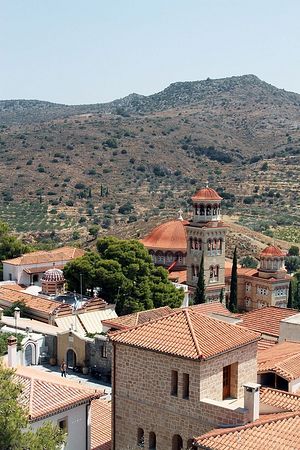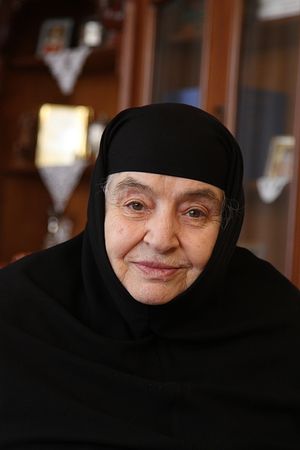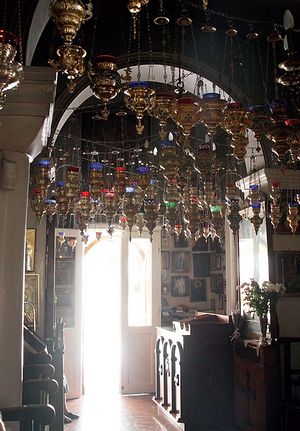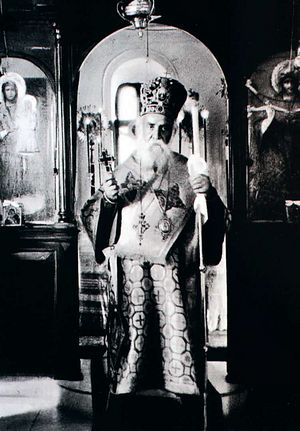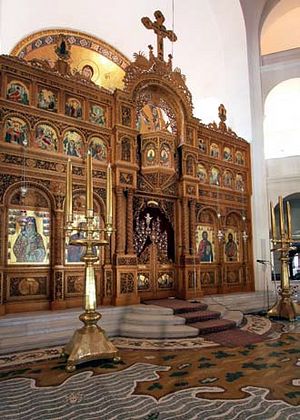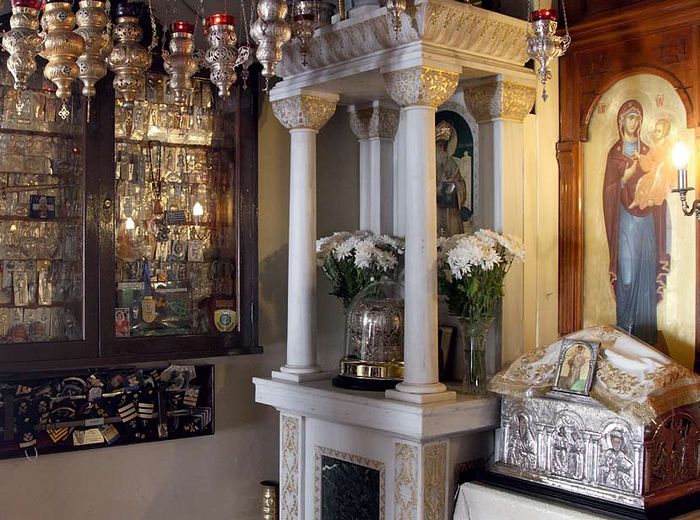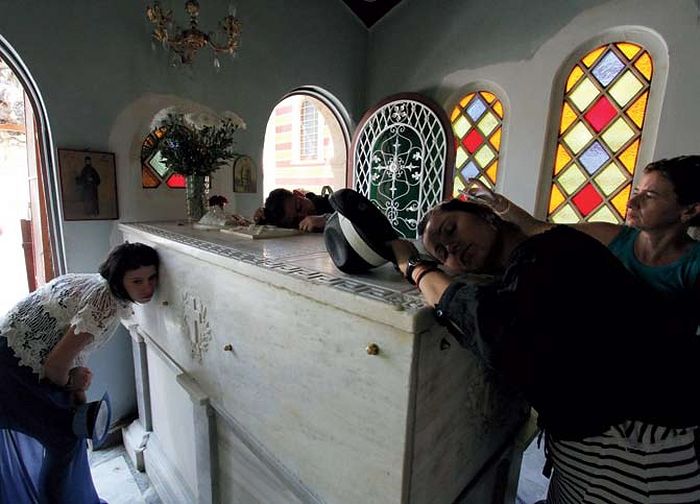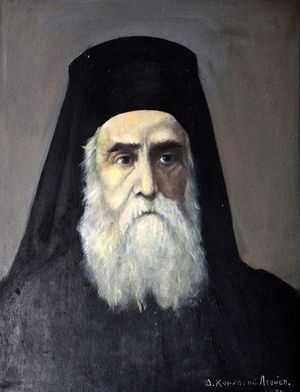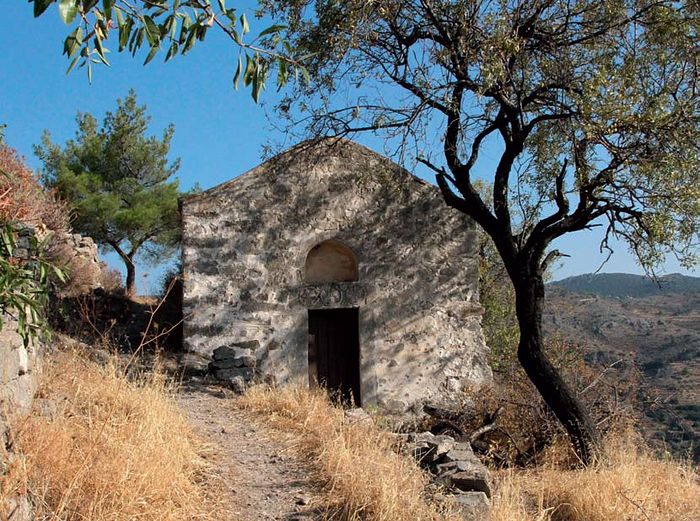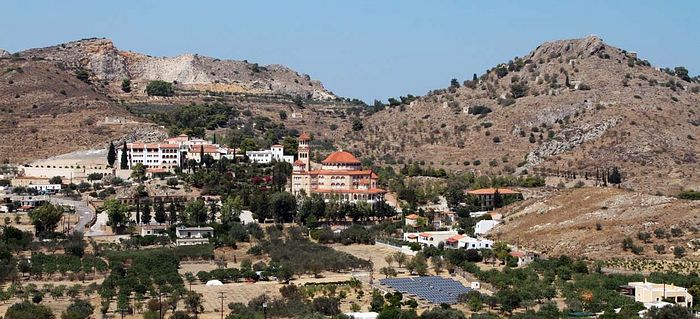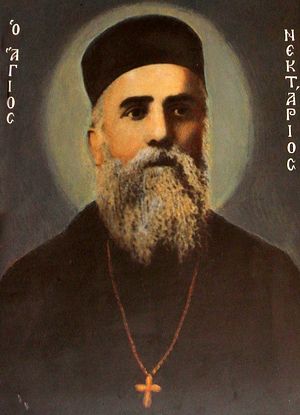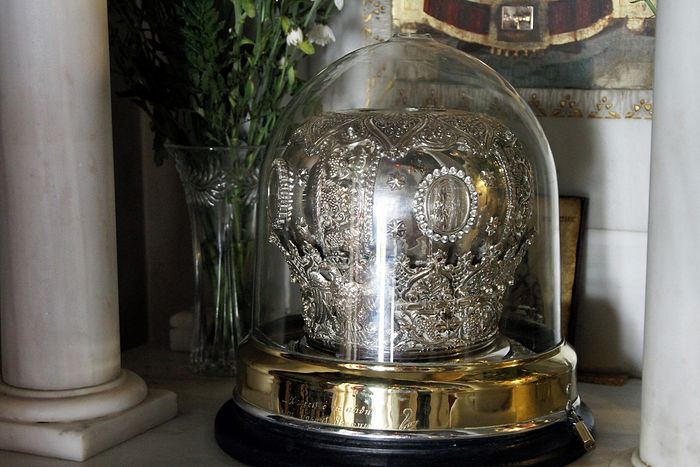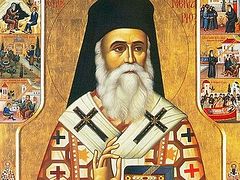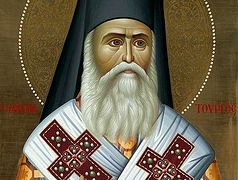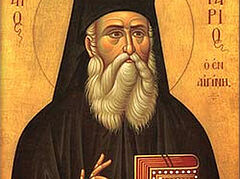One of the issues of the journal Monastery Herald is dedicated to the monasteries of the island of the Aegean Sea. With the kind permission of the publisher, material from this issue—a conversation with the abbess of the Holy Trinity Convent on the island of Aegina, Gerontissa Theodosia—was published on Pravoslavie.ru.
***
The Holy Trinity Convent on the Greek island of Aegina attracts thousands of pilgrims every year, regardless of the economic and spiritual crisis, which, in the opinion of the nuns of the monastery, both exist now in Greece. The people go to visit one of the most revered Greek saints of modern times—St. Nektarios, Metropolitan of Pentapolis, or, as he is now known, of Aegina. Pilgrims who come to the monastery experience both visible and invisible miracles.
Holy Trinity Monastery is not just a pilgrimage center, but it is home to sixteen nuns, whose labors and prayers support the spiritual life there.
The sisters do not tell about the inner life of the monastery without the blessing of the abbess. Even if she blesses to give an interview, they think about every word: what it is possible to speak about and what not. In light of this, a picture was painted in our imagination of a strict and inaccessible abbess.
When they told us on the second day of our pilgrimage that Mother would receive us, we were very surprised. In the end, our conversation was warm, and we were so excited that we forgot to ask the abbess’ last name. Later, when we called the monastery from Russia, the monastery secretary Nun Christonimphi answered, “I don’t even know. Why? Everyone in Greece knows her as Theodosia from Aegina.”
Gerontissa Theodosia almost never appears in public, rarely gives interviews, and there are no photos of her on the internet. Therefore, our conversation on the page “Monastery Herald” is exclusive and very lucky. Nun Philotheia translated for us from Greek.
The Hesychasterion of St. Nektarios
—Dear Mother, people come to your monastery from around the world to kneel at the relics of St. Nektarios, known for many miracles. In the Russian version of his akathist it says, “Rejoice, thou who hast acquired the glory of St. Nicholas the Wonderworker.” Surely this all cannot but affect the life of the monastery.
—Of course! Miracles happen here constantly. And even right now, I am sure that St. Nektarios is performing a miracle somewhere. I receive a great number of letters where people describe what happened with them after their pilgrimage to Aegina. We collect all the letters, and if we published them, it would take up many thick volumes.
Sometimes miracles happen right here, in the monastery. Literally just two weeks ago, a patient in a wheelchair came here—he couldn’t walk. He prayed in the saint’s cell, venerated his bed, and stood up and walked…
It is impossible to speak about the life of our monastery without mentioning the name of St. Nektarios. For us, the main thing is the example of his holy life and his teachings. We should try to imitate him in everything.
—Does the large flow of pilgrims affect the daily routine of the monastery?
—You know, no one winds up here if St. Nektarios himself doesn’t want it. For us, that means we have to work hard for the people who come here. Therefore, as opposed to practically every Greek monastery, we don’t have a siesta. Our doors are open from sunrise to sundown. It’s very convenient for pilgrims.
We serve a moleben to St. Nektarios every day at 11:00 AM, which always has a lot of people. If necessary, the nuns lead tours around the monastery, giving attention to the pilgrims. Sometimes our daily obediences have to be postponed because of it—the sisters can do their work only after the evening service.
We have good living conditions, and the nuns don’t even have to leave their cells—they can focus on their prayer rules. It gets dark early in the winter, and we live more secluded.
—Is the church also open during daylight hours?
—Yes, the church is open, and there is always access to his relics, to his cell, and to the place where he was buried. The store is open all day, where we sell all kinds of icons, postcards, books, and oil, so people can buy something in memory of St. Nektarios. We also have a free guests house, where you can stay for a night if there is available space. It’s possible to stay longer; it’s decided separately in each specific case. The guest house has a trapeza.
—You said there is a moleben every day. And Liturgy?
—We also have daily Liturgies. It’s very important. Every sister comes to the services when she is able. If you have been to other Greek monasteries, then you know that there isn’t daily Liturgy everywhere. In the best case, they serve once a week and on the Great Feasts, because there aren’t enough priests. Thank God, we have a permanent priest. He is a married priest, living in the city.
From the first sisters’ recollections of St. Nektarios, we know that he served the Liturgy such that no one wanted it to ever end. Sometimes, when the time for the services came, you felt as if you weren’t touching the ground. There’s a picture of the saint during his final Liturgy in his cell. Make sure to see it.
—I can confirm that Liturgy goes by in one breath in the monastery now; we felt it. St. Nektarios is not yet as widely known in Russia as in Greece, Serbia, and Romania. People often find out about this saint when they are faced with some serious illness. But you probably knew about him from childhood?
—Yes. When I was in fifth grade, I came across a book about the saint—I don’t even remember who gave it to me. Having read this book, I decided that I absolutely had to go to the monastery of St. Nektarios someday.
—And how long until you went to the monastery?
—It wasn’t immediate. I’m from the city of Missolonghi, which is on the coast of Greece across from Aegina. Of course, by Russian standards it’s a small distance, but for us, in those years it was far. I first managed to visit Holy Trinity Monastery only when I went to Athens to study to be a lawyer. After that, I went every year. I have been in the monastery permanently since I retired, and before that I worked in a bank.
—How did it happen that you became the abbess, and how long have you been the abbess already?
—Oh, I don’t even remember (laughs). But seriously, it’s been fourteen years already. Our monastery is managed by the abbess and the monastery council. St. Nektarios arranged the monastery like a hesychasterion. That means the local bishop doesn’t interfere in the life of the monastery. He doesn’t appoint the abbess, he can’t take any sisters from here, and he can’t send new ones. A hesychasterion monastery is more autonomous than a usual monastery. The abbess is chosen by the monastic council, which consists of the schemanuns. And they chose me.
—So people can come from any part of the world and ask to join the monastery?
—Yes; the council and I decide to take someone or not.
—What do you pay attention to first in this regard?
—It’s hard to name the specific parameters we use to decide. We receive new sisters who jibe with the spirit that exists in the monastery. Just as the person chooses the monastery, the monastery looks to see if this person fits it. We have sixteen sisters now; of them, one is Russian, two Romanian, and the rest are Greek. The ages range from twenty to eighty.
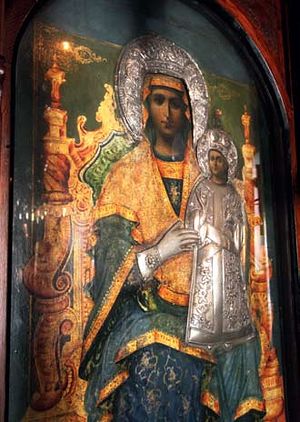 The icon of the Mother of God on the iconostasis in the Church of the Holy Trinity—one of the churches of Paleochora
The icon of the Mother of God on the iconostasis in the Church of the Holy Trinity—one of the churches of Paleochora —It’s impossible to answer here definitively. On the one hand, I think there’s no need to rush to take many new sisters. It’s like boiling water: If you pour too much cold water in it, it cools down. The same thing happens in the spiritual life. On the other hand, we have an innumerable flow of pilgrims, and not everyone wants to live constantly in sight. Many are seeking more solitude, and such opportunities abound in Greece.
—Does the monastery have a skete where the nuns can be alone? From the monastery terrace you can see a hillside where there are a great many tiny churches. They’re not your sketes?
—That’s the holy mountain of Paleochora you’re talking about. Paleochora was the capital of the island for a thousand years. The mountain is unique in that on such a tiny territory there were over 300 churches and family chapels. It’s also a place of martyrdom: The Turks killed many here, including priests. The churches of Paleochora were a favorite place for prayer for St. Nektarios. Thirty-four of them have survived, many in a state of disrepair.
We used to go serve there. After the mountain was transferred to the jurisdiction of some archaeological organization, they didn’t allow us to have services there. But either way, I advise you to go there and see these ancient churches. Paleochora is a very spiritual, wonderful place—the hills, the wind in the leaves of the trees, the sun, the chirping of birds, the churches on the slopes—and what’s more, no one around. You should see it and feel it.
We don’t have such sketes. But as for the question about solitude, the monastery has churches not far away. Right behind the monastery is the Church of the Holy Protection of the Most Holy Theotokos where the sisters can go and pray in silence. Right now we’re building a house there where you can stay.
Obedience and attentiveness
—Mother, tell us please, what, in your opinion, is the most important thing in the monastic life?
—To come to a monastery, a person must have a definite beginning. I call it wandering. That is, he must leave everything: mother, father, school, work, home. When he comes to the monastery, then he should have blind obedience here. Without obedience, a spiritual life is impossible in a monastery.
It’s impossible to learn obedience immediately, so there exist various degrees of monasticism. The first is the novitiate. The novices are tested and observed for a certain period (for some more time is needed, for others less). Then, together with the monastery council, we contemplate the tonsure into ryassaphore. Later we decide the question of the great schema—the highest degree of monasticism. In general, the main thing in a monastery is obedience.
—That’s for the sisters. And for the abbess?
—For an abbess, the main things are love and patience. When a sister comes to the monastery, she leaves everything, so the abbess, receiving her, should become a mother for her—not too strict or harsh, but soft, like a real, good mother.
—How then does this mix with the blind obedience you spoke about? If someone is soft, there won’t be obedience to them.
—No, that’s not true. You understand, a person who comes from the world at least desires the monastery, but in fact doesn’t understand anything about the monastic life. Therefore, you can’t immediately demand a lot. You have to understand the person, and see what he or she is able to do. Patience will put everything into its place.
Comments should not be made rudely. Rudeness and excessive strictness, especially in convents, leads to despair. The abbess must have a lot of patience and love, so the sisters would perceive her as a mother, not concealing their thoughts from her. In actuality, I only seem strict. I love freedom in people, and don’t pressure anyone. I govern only with my eyes, and I’m called an abbess, but in essence I’m a democrat (laughs). Women were created to love, and men to lead.
—Which of St. Nektarios’ precepts do you consider that the sisters in your monastery should follow?
—We should follow everything that St. Nektarios said. To be more specific, for example, he taught the sisters: “On one hand write ‘obedience,’ and on the other ‘attentiveness.’”
—What did he have in mind with “attentiveness?”
—Firstly, attentiveness to oneself. We must gauge our every word and ever deed. To look into the depths of one’s own heart: whether your conscience convicts you for transgressing the commandments, whether your heart is filled with evil and passions, whether you have lost your boldness before the Lord.
Secondly, you have to be attentive to the sisters around you. St. Nektarios noted that every nun should sincerely and simply give another sister everything she asked for. In his letters to the sisters, he would say, “Have love, and may you always have prayer and peace between yourselves. Be as children; try to be like unto the Lord.”
—Were any of the external rules of the monastery established by St. Nektarios?
—After we close the doors of the monastery in the evening, there should be no men left on the territory. During the services, men (except for clergy, of course) are not allowed to go to the central aisle of the church.
—St. Nektarios bore great love and peace within himself. It is hard for modern man to imagine how it was possible to endure so much slander and so many persecutions and not become hardened against the whole world. His trials only exalted and transfigured him. Can you advise us how to endure injustices?
—Indeed, just think: Patriarch Sophrony of Alexandria was already ninety years old when he expelled Vladyka Nektarios from his cathedra, seeing in him a competitor! In 1998, Patriarch Peter of Alexandria brought to our monastery a large papyrus in which the patriarchate officially asks forgiveness from the saint for what happened 107 years ago, when he was slandered. The papyrus is hanging in St. Nektarios’ cell.
He was persecuted nearly his entire life. And here also, on Aegina, he was defamed. But he never complained, and remained kind to people in every situation. But in the righteous one’s humility, the envious saw hypocrisy. He was belittled even after death. When they uncovered his incorrupt relics in the 1930s, the archbishop of Athens, not believing in Vladyka Nektarios’ holiness, ordered his body to be left out in the open air, so it would decay. But it didn’t happen.
You know, there is much slander and deception in the modern world. Whoever falls into such a situation, let him turn in prayer to St. Nektarios of Aegina, and he will help; he will comfort.
—Who undertakes the spiritual governance of the monastery today?
—Our spiritual father lives on Mt. Athos, in the Grigoriou Monastery. He comes to us to confess us and give us guidance, and to hold spiritual talks. One of our nuns works very closely with Grigoriou Monastery. Grigoriou has a metochion in the Congo, and our spiritual father blessed this sister to go there. She’s been doing missionary work in Africa for nearly a year already, and has opened several schools in the Congo for teaching catechism.
Pines, pistachios, and mercy
—In Russia, much attention is devoted to the social activities of churches and monasteries. Is there anything similar in Greece?
—If we turn to history, there is a tradition that with the appearance of St. Nektarios on Aegina even the climate on the island changed. As with all the saints, he loved nature, and he brought about 5,000 pine trees here. Now the island is green, with curative pine air and a mild climate. Additionally, the saint brought pistachio trees to Aegina. The most delicious pistachios in Greece grow here, and there’s even a pistachio festival.
Thanks to St. Nektarios, our monastery, I can say, is flourishing. Therefore, we have the opportunity to support the needy, of which there are many on the island. The local city hospital is mainly provided for by monastery funds. The monastery also materially supports students and poor families.
It’s hard times now, and many residents (fishermen, construction workers) have no work or business. The monastery helps them: It buys fish from the fishermen and takes them to a special center where they cook food for the poor, elderly people, or they distribute it to other monasteries.
The sisters and I are not in need, and we can help people, but St. Nektarios often gave his very last. If he had no money, then he would give away his clothes and shoes. He lived very modestly, not even having a bed until the very last months of his life. The one you saw in the cell is the bed of St. Nektarios’ grandmother, which his nephew brought not long before the saint’s blessed repose.
—You mentioned a center where they prepare food for low-income seniors. Tell us more about how it works.
—On the outskirts of the city of Aegina, in a building which was made available to the center by two benefactors, a kitchen has been organized. They cook food there for the elderly who have no pension, or children or those who are bedridden—that is, those who for some reason are unable to independently provide themselves with food.
Once a day, at 12:00, food is prepared, which is then delivered to the addressees (two people cook, and two deliver). The volunteer center delivers food throughout the city, and for people further away, the lunches are picked up by some local volunteer.
The center exists due to our monastery, and thanks to private donations. For example, bakeries can bring the bread they didn’t sell that day, vegetable stands—vegetables, local supermarkets offer transportation, and so on. The center has existed for more than twenty years, with more than seventy people under its care. The center is directed by a priest.
—And the people who are building the housing for you in the monastery, who clean in the church, who cook food in the monastery guest house—are they hired employees?
—Of course, our sisters have obediences in the trapeza, in the church, in the guest house, or in the garden; but still, there are few of us, and we cannot manage such a volume of work on our own. Therefore, we hire people. There are times when we take people on to work just because we see they are in need and are greatly despairing because of it.
Again, it’s a kind of testament to us from St. Nektarios. He would often go to the port, and if he saw someone sitting in a cafe and drinking out of desperation, he would invite him to the monastery under the pretext of making some money. He usually asked them to come Sunday morning. The person would come, and the saint would say to him, “Come, let’s go to church right now, because it’s the Sunday Liturgy.” Then, “Well, it’s already noon, let’s have some breakfast.” Only then would he give some work: To move some flower pots from place to place, or some other simple tasks—and he would pay enough so as not to offend the person. Thus, people had something to do, and they did it in the monastery, where they would also pray. Their lives would slowly come together.
Today there are very secular Aeginians who have absolutely no connection to the Church. They come to the monastery as needed to get some work. In the monastery they hear the word of God, and pilgrims tell them about the miracles of St. Nektarios, and they change their lives.
“I will spread my cowl over Aegina”
—Mother, is the large cathedral next to the monastery part of the monastery? Who built it?
—They’ve been building the Cathedral of St. Nektarios for several decades already. Yes, it belongs to our monastery, and we are financing the building. They’re working on frescoing it now. We attracted the best specialists for the cathedral. There is a beautiful mosaic inside of the Mother of God “More Spacious Than the Heavens.” I think it’s the best example of mosaic art in all of Greece.
—That reminds me of words from the hymn “O, Pure Virgin”(“Agni Parthene”). By the way, we sing this hymn now at Liturgy before Communion. You have very beautiful singing in your monastery.
—Probably every believer in Greece knows “O, Pure Virgin.” As for the choir, we try to continue this work of St. Nektarios. When he opened the monastery, he invited Fr. Savvas from Kalymnos Island (he is also a canonized saint, known as Savvas the New), to teach the sisters iconography and Byzantine singing. In our times, the sisters do a lot of singing, but not everyone—only those who have the aptitude for it.
Given that I’ve already mentioned Fr. Savvas, he lived here six years after St. Nektarios, and I think he was the first to publicly speak of St. Nectarios’s holiness. A few months after the repose of the holy hierarch, Fr. Savvas secluded himself in his cell for forty days. Once this time had passed, he came out, holding in his hand an icon of St. Nektarios, and ordered it to be placed in the church on an analogion. The abbess objected that Vladyka was not yet canonized, and that they could be punished for it, to which Fr. Savvas replied that she should show obedience and not insist upon analyzing the will of God.
—Yes, sometimes we have to wait a long time for a Church glorification. In Russia, for example, many believers are waiting for the canonization of three monks from Optina who were killed on Pascha in 1993. And not just them. We have a book called Everyday Saints about people of holy life but not officially canonized.
—I have read this book. I really liked it! If you publish this interview, write that I personally invite Vladyka Tikhon (Shevkunov) to visit our monastery and serve the Liturgy with us. Make sure to tell him!
—We will try to give him your invitation. And have you yourself been in Russia?
—I haven’t had the chance yet, but I really love Russians, because we’re of one faith. In Russia, after seventy years of the godless authorities, of the destruction of their way of life, I would imagine it’s difficult to establish the monastic life. It’s very difficult for people to fulfill the oath of obedience. But everything comes together gradually.
Greece also had communism, I mean in the sense of theomachy. In 1848, people came to power who destroyed the monastic life in all the monasteries. The Royal Council consisted of leaders who obliged monastics to marry. When a truly Greek government stood at the helm, everything gradually returned to normal.
Today, there is danger from Turkey hanging over us. But I believe that St. Nektarios will protect us in any case. During the war with the Germans, Aegina did not suffer at all. It has an important position in the sea, as it is the closest island to Athens, and the enemy should have bombed everything here. The sisters had already started digging a bomb shelter here when St. Nektarios appeared to them and said, “Fear not, I will spread my cowl over Aegina.” The fascists flew here, but they couldn’t see the island. Even ships sailing towards Aegina were invisible for the Germans.
—Mother, do you have some dream?
—I really want the Russians to take Constantinople, as St. Paisios the Athonite foretold, and that after that, we, Russians and Greeks, would build a monastery to St. Nektarios together in his homeland of Silivri.1
—Thank you for the warm welcome. We hope to come to your monastery again sometime.
—Come again, and bring the magazine with you!
It’s interesting to visit on the feast of St. Nektarios in November, to see the people’s love for him. We process to the city with his head, and there the people cover the streets with carpets and hang portraits and icons of the saint from their balconies. It’s a very beautiful feast.
It’s good that you’re still children. May the Lord bless you! Leave your address, and if we’re ever in Moscow, we will certainly find you.
Such an attitude touched us. Of course, for the wise Abbess Theodosia, we are children. The nuns call her “Gerontissa,” which means “Eldress.”

